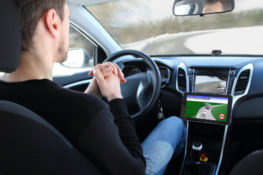
The North American International Auto Show (NAIAS) showcases some awesome new developments in new car technology, including safety innovations. The show, which took place January 11th through 24th in Detroit, point to the future of automobiles and is a reminder that the way people travel will likely change significantly in the next 10 years.
- Self-Driving Cars
Some of the most popular vehicles at the North American International Auto Show this year were self-driving cars. Autonomous vehicles operate entirely on their own without any assistance by a human driver.U.S. Transportation Secretary Anthony Fox announced at the auto show that self-driving vehicles have the potential to improve safety on U.S. roads and estimated that widespread adoption of autonomous vehicles could prevent 25,000 traffic deaths a year, according to The New York Times. The federal government proposed spending $4 billion to develop a regulatory framework for self-driving vehicles and invest in research to bring autonomous vehicles to the market more quickly. Several automakers have pledged to have self-driving cars ready to sell within a decade. The biggest concern that most people have with self-driving cars is that they will not do as good of a job of driving as an actual driver, according to an article on NPR News. At the auto show, the featured self-driving cars did more than just operate themselves. They took passenger comfort to a new level. Consider, for example, the Mercedes-Benz F 015: the vehicle has a built-in lounge of sorts, allowing passengers to relax in swivel chairs that can turn to face one another for conversation. Walnut flooring completes the concept.It is important to note that despite the fact that the technology is here, self-driving vehicles are not allowed on roadways. The issue of liability that must be resolved: in the event of a crash involving a self-driving vehicle, who would be held responsible?Not all of the cars that were introduced at the show are completely able to drive themselves, but many have features that may make driving safer, if not more convenient.For example, the Super Cruise 2016 Cadillac sedan can brake, accelerate, and keep in its lane all on its own. Many cars that are made today already have a variety of similar features, such as parking and back-up assist. - Virtual Reality Driving Simulators
Another hit at the NAIAS was the advent of virtual reality driving simulators. Drivers sit in stationary vehicles, like a Dodge Viper which then vibrates and moves over “bumps” in the road –remember, the car is actually stationary – and allows drivers to experience the sensation of moving at speeds of more than 100 miles per hour. You can read about one reporter’s experience in the Viper first hand in an article published by The Detroit Free Press. Other car makers had similar hands-on exhibits. A display at the Denso International America booth allows drivers to sit behind a steering wheel and a couple of large screens. A digital experience guides drivers through autonomous driving, showing how a vehicle can narrowly miss a crash all on its own when merging onto a highway. - Cars that Coach
What if your car could do more than just drive? What if it could coach you on how to be a better driver yourself? The possibility of this is not far away. The vehicles would actually collect data on drivers and passengers (with drivers’ and passengers’ permission). The data would be used to provide information to drivers that could coach them on better driving habits. Or, the data could also provide information about how to get a better fuel economy, or give drivers real-time updates about changes in traffic conditions. FordPass, which was showcased at the Detroit Auto Show, is similar to OnStar technology. It will help drivers to find everything from a parking space to a restaurant. The goal of the new technology is to make driving safer and also to make drivers’ lives more convenient as well.
Detroit Auto Show Recap and the Future of Car Safety
The Detroit auto show provided insight into what is to come in the future regarding automobiles. In the future, technology in cars may advance to the point that smart cars might be able to turn on the heat in homes before we arrive, or inform us that we need to pick up groceries. They also may be much safer than we ever imagined. After all, it was only in the 1950s that car manufacturers began offering seatbelts. Who knows, in 10 years’ time or less, vehicles may be so smart that they avoid traffic accidents altogether, eliminating auto-related deaths and injuries and providing people with a safer way than ever before of getting from one place to the next.
Let us not forget the advances in energy as well – cars are being developed today using renewable sources of energy rather than gas, with the end goal of reducing our dependence on fossil fuels.
How the New Car Technology Affects Drivers Now
At Herrman & Herrman, we are interested in the innovative safety technology being introduced in new cars, which will ultimately make our communities safer. To increase awareness about technological innovations and to increase safe driving, and to help those in our community, we sponsor the Innovation Scholarship. The winners of our 2015 Innovation Scholarship have been announced!
For the time being, self-driving cars are a futuristic exhibit at auto shows. Do not expect these vehicles to be commercially available in the next year or two. That being said, all error behind the wheel continues – for the most part – to be human. If you are involved in an accident caused by a negligent driver in Corpus Christi or anywhere in the Rio Grande Valley in Texas, the experienced car accident attorneys at Herrman & Herrman are ready to help you.








